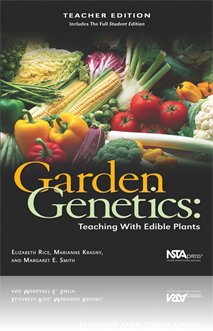All Book Chapters
Book Chapter
It Skips a Generation: Traits, Genes, and Crosses (Student Edition)
Long before they understood why the strategy worked, farmers knew how to crossbreed plants to obtain more desirable traits. Even today, a farmer who knows nothing about genetics can tell you that when a blue type of corn crosses with a yellow one, t...
Book Chapter
It Skips a Generation: Traits, Genes, and Crosses (Teacher Edition)
Many of the early discoveries in genetics occured in plants. Plants have a few special characteristics that make them ideal for studying genetics. From one known cross, many genetically similar "siblings" are produced. Building from Gregor Mendel's c...
Book Chapter
Bitterness and Non-Bitterness in Cucumbers: A Story of Mutation (Teacher Edition)
In this chapter, students explore the history of the bitter gene in cucumbers, which was found in a genebank and traded internationally between cucumber breeders. The students then explore transcription, translation, and the DNA basis for different t...
Book Chapter
Survival Strategies (Teacher Edition)
This chapter focuses on ecological principles of plant defenses and insect adaptations to these defenses. Insects either are generalists, often deterred by plant chemical defense compounds, or they are specialists that are attracted to the defense co...
Book Chapter
Domestication: Evolving Toward Home (Teacher Edition)
This chapter explores the concept of domestication and the changes that occur in plants as they transition from wild to cultivated. Domestication is a form of evolution driven by artificial selection rather than natural selection. Two theories of evo...
Book Chapter
The Risks of Improvement: Genetic Uniformity and an Epidemic (Teacher Edition)
This chapter explores the role of genetic diversity in crops. Using hybrid corn as an example, it discusses selection—the genetic narrowing that accompanies gains in traits like yield and disease resistance—and the ecological and evolutionary con...
Book Chapter
Genetic Engineering (Teacher Edition)
This chapter focuses on genetically engineered foods. Bt corn has bacterial genes that encode a protein toxic to many insects. Therefore the corn plant makes its own pesticide. This chapter explores the DNA basis for this genetically engineered plant...
Book Chapter
Sweet Genes in Corn (Teacher Edition)
This chapter begins with consideration of sugars made by the plant during photosynthesis and the movement of those sugars within the plant by diffusion along concentration gradients and by other processes. By exploring the genetic basis of sweet corn...
Book Chapter
Centers of Diversity (Teacher Edition)
This chapter discusses genetic diversity of food plants in the context of the geographic regions from which they originate. The center of origin is the site where the plant was domesticated. The center of diversity is the site where maximum genetic d...
Book Chapter
Quantitative Traits (Teacher Edition)
This chapter begins with single-gene Mendelian traits and compares them to quantitative traits where many genes are involved in determining phenotype. Quantitative trait loci (QTL) studies use molecular markers to pinpoint which sections of DNA are a...
Book Chapter
Bitterness and Non-Bitterness in Cucumbers: A Story of Mutation (Student Edition)
The bitterness of cucumbers is caused by a protein called cucurbitacin. The protein is found in the stems and leaves of many cucumber plants and this is why some people remove the skin and seeds before eating them. The objective of this activity is t...
Book Chapter
Survival Strategies (Student Edition)
Plants are part of complex ecosystems. They must defend themselves from predators. They also must compete with other plants for light, soil, nutrients, and water. Over time, plants have evolved many strategies for defense and competition. In this cha...
Book Chapter
Domestication: Evolving Toward Home (Student Edition)
Domestication is literally the process of bringing an organism—animal or plant—into the home. It's easy to see the evolution from wild wolf to docile dog as domestication. A domesticated plant is one that is dependent on humans for its survival,...
Book Chapter
The Risks of Improvement: Genetic Uniformity and an Epidemic (Student Edition)
In 1970, an epidemic swept through corn crops in the United States. The farmers alleged that the seed companies had behaved irresponsibility in releasing corn varieties that all had the same gene for T-cytoplasm, and that they should be financially r...
Book Chapter
Genetic Engineering (Student Edition)
Genetically engineered crops cross boundaries that traditional crops do not and pose new and challenging regulatory issues. In the United States, a number of government agencies regulate food, plants, pesticides, and agriculture. Who regulates a plan...



